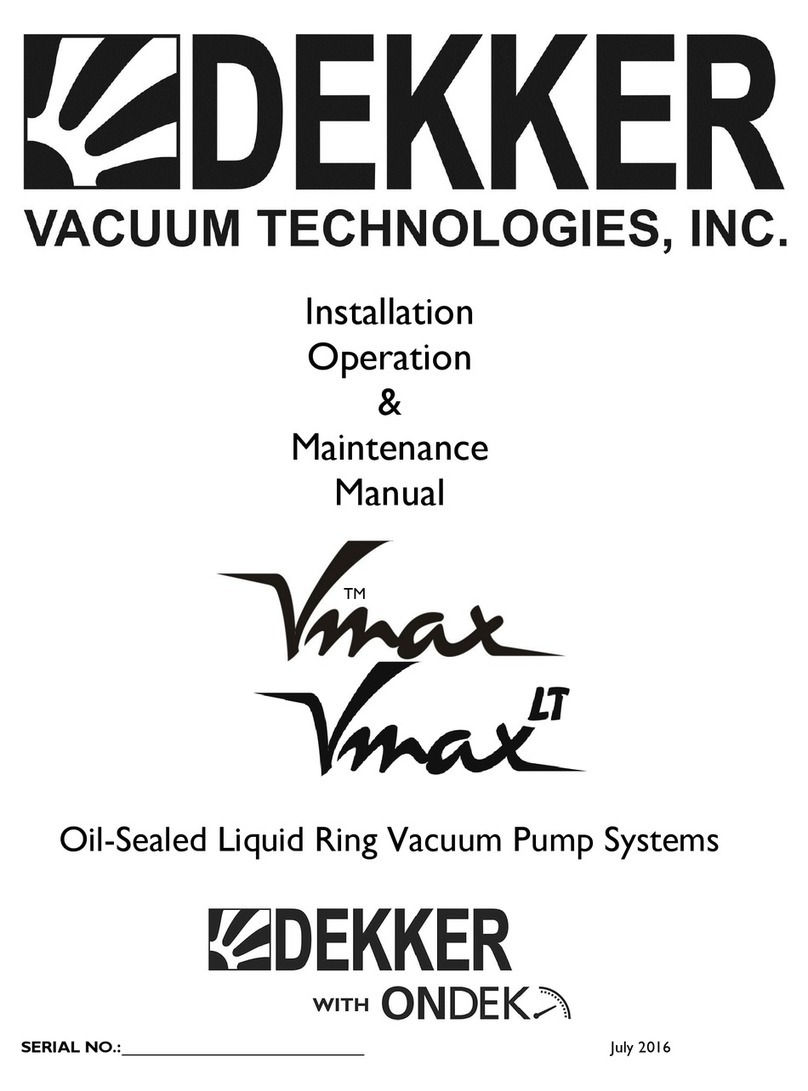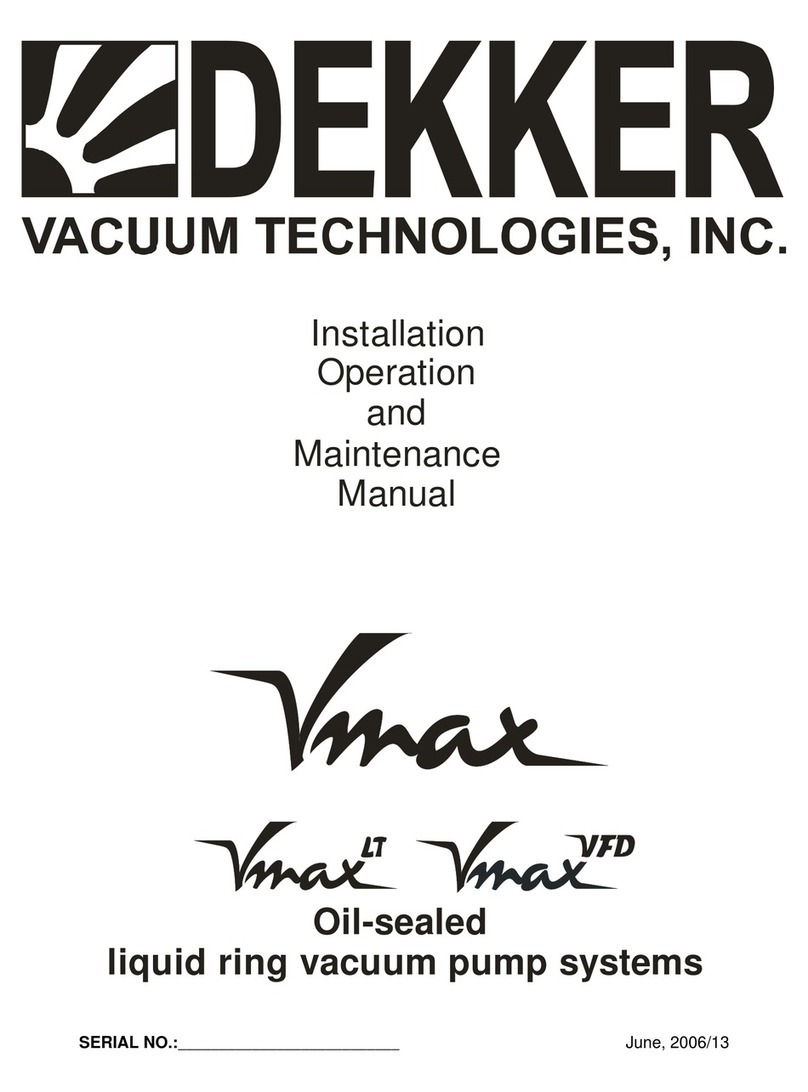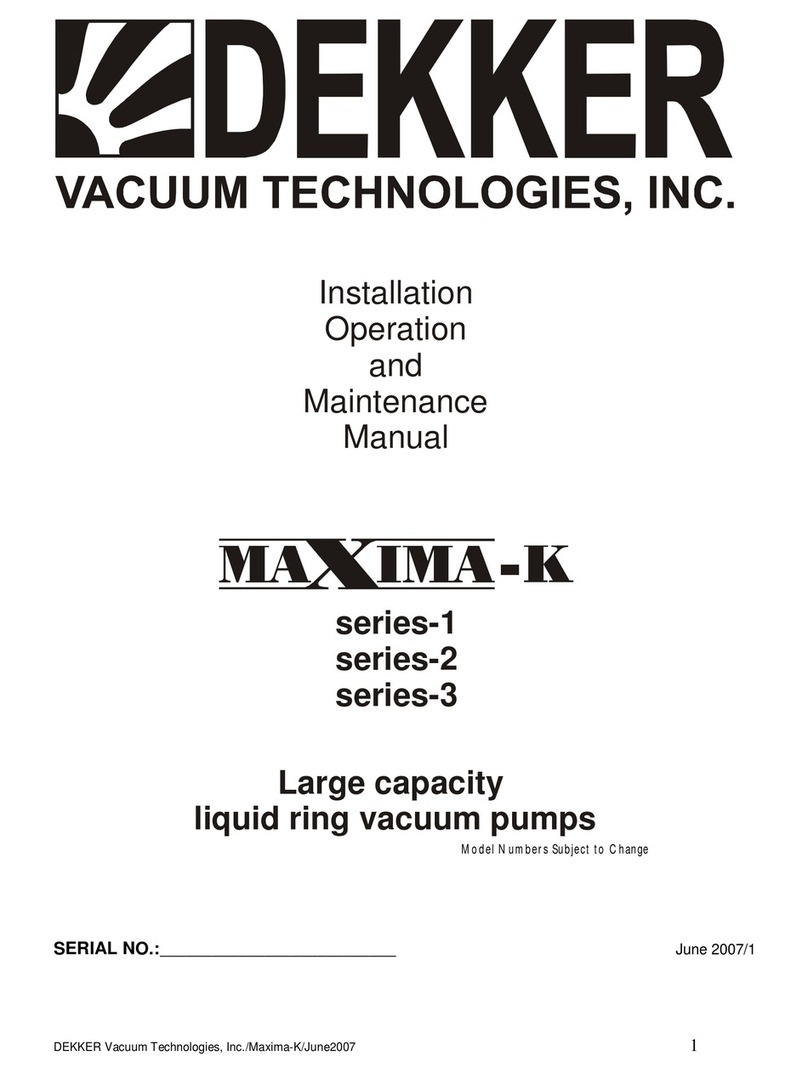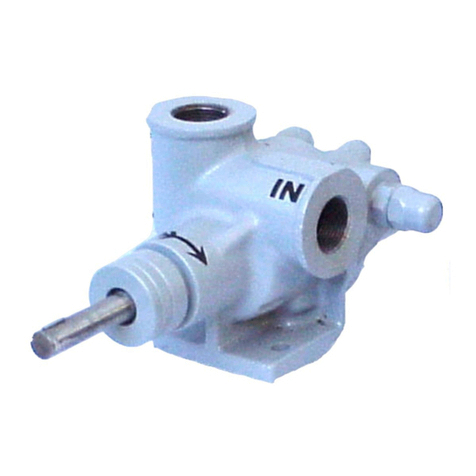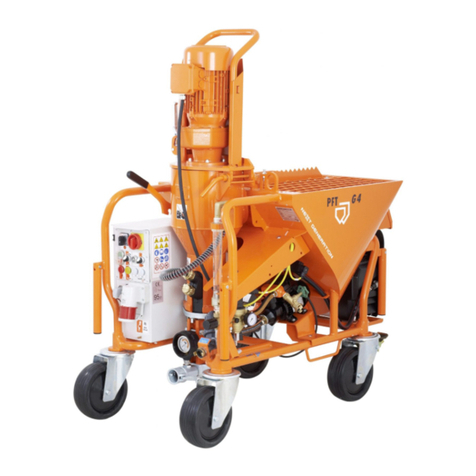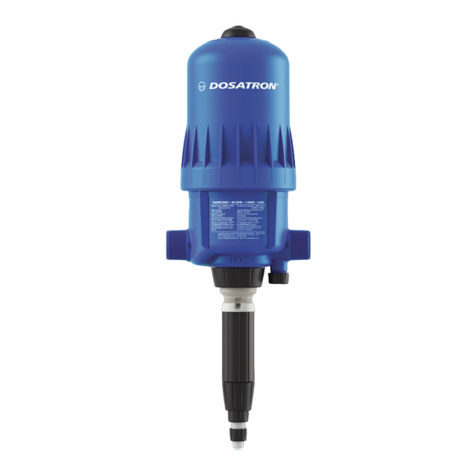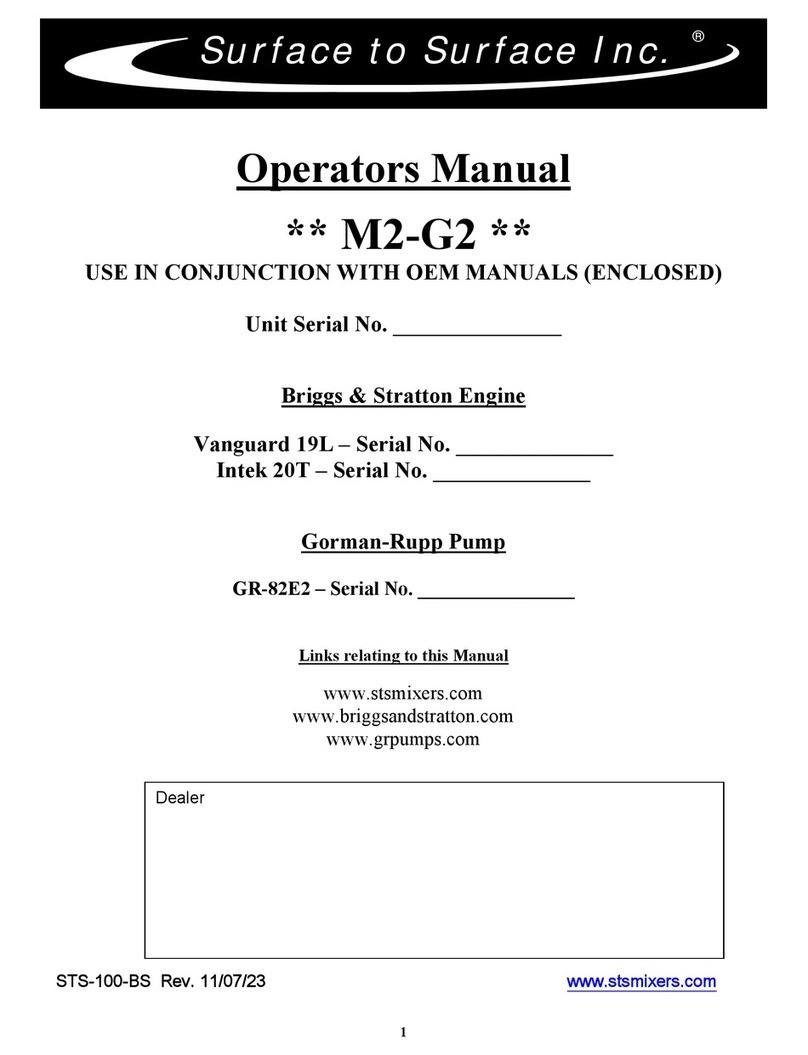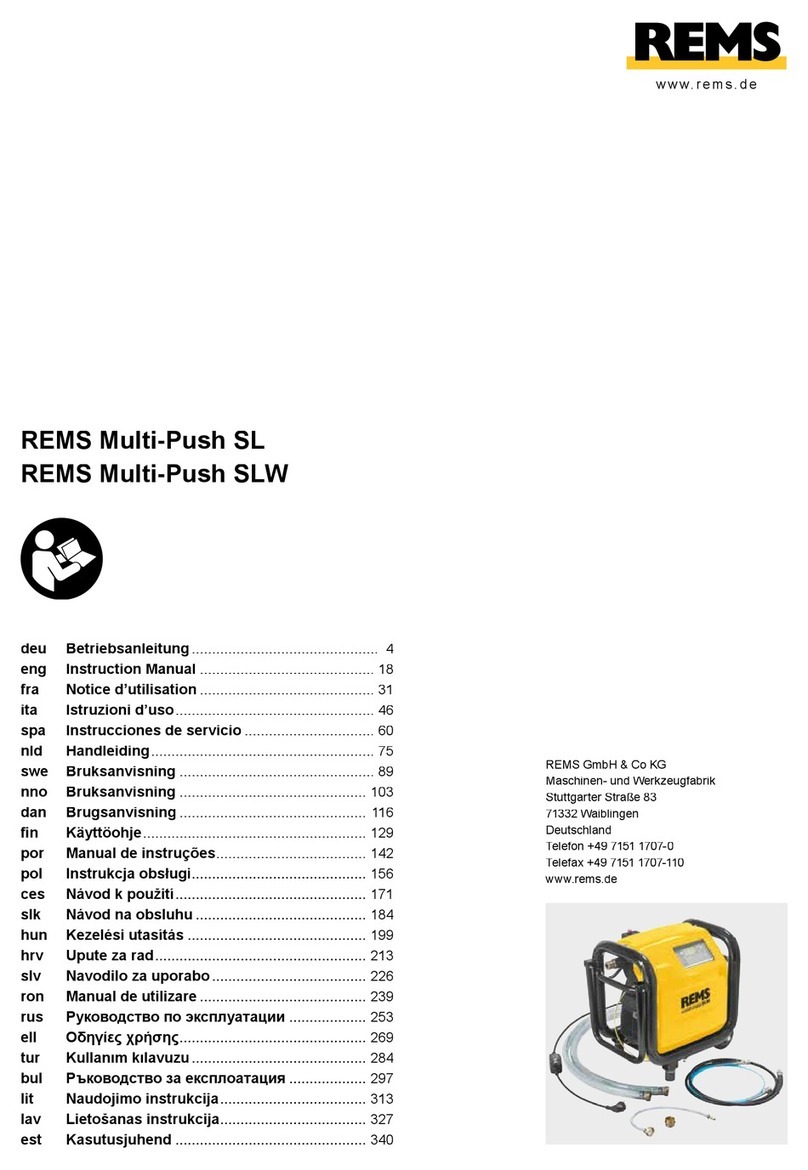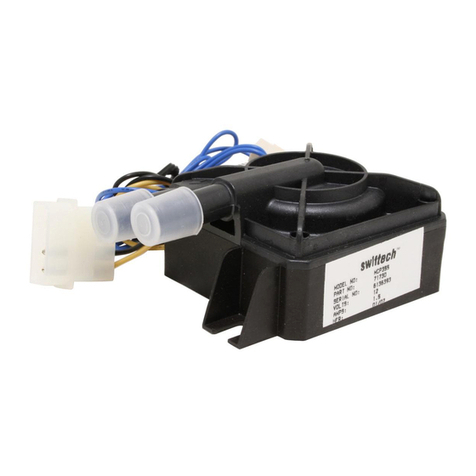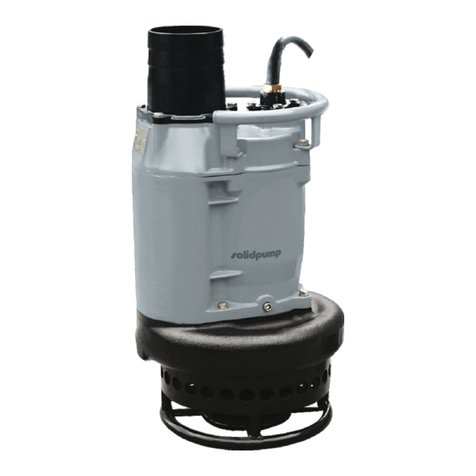Dekker HullVac HV55A Instruction manual

Installation
Operation
&
Maintenance
Manual
Rotary Piston Vacuum Pumps & Systems
SERIAL NO.:___________________________ September 2016

DEKKER Vacuum Technologies, Inc. –HullVac / September 2016
2
ROTARY PISTON VACUUM PUMPS & SYSTEMS
TABLE OF CONTENTS
CUSTOMER SERVICE................................................................................................................................ 5
CONTACT INFORMATION ........................................................................................................................................................................5
ORDER INFORMATION ..............................................................................................................................................................................5
INTRODUCTION ....................................................................................................................................... 6
SAFETY........................................................................................................................................................ 6
THEORY OF OPERATION........................................................................................................................ 7
STORAGE.................................................................................................................................................... 8
INITIAL FREIGHT RECEIPT AND INSPECTION .................................................................................. 8
INSTALLATION ......................................................................................................................................... 8
UNPACKING ...............................................................................................................................................................................................8
LIFTING........................................................................................................................................................................................................8
LOCATION..................................................................................................................................................................................................9
MOUNTING.................................................................................................................................................................................................9
VENTILATION/COOLING ..........................................................................................................................................................................9
COOLING CAPACITIES AND PORT SIZES ..............................................................................................................................................10
ELECTRICAL PREPARATION.....................................................................................................................................................................10
PIPE CONNECTIONS AND SIZING..........................................................................................................................................................10
INLET PIPING.............................................................................................................................................................................................11
DISCHARGE PIPING ..................................................................................................................................................................................11
COOLING WATER PIPING (WATER COOLED SYSTEMS ONLY) ...........................................................................................................12
ELECTRICAL CONTROLS (IF INCLUDED) ......................................................................................... 12
START UP PROCEDURES ...................................................................................................................... 13
BELT TENSION FOR V-BELT DRIVES.......................................................................................................................................................15
SHUT DOWN PROCEDURE .................................................................................................................. 19
MAINTENANCE SCHEDULE ................................................................................................................. 20
DURING FIRST MONTH OF OPERATION...............................................................................................................................................20
EVERY DAY ...............................................................................................................................................................................................20
EVERY 3MONTHS ....................................................................................................................................................................................20
EVERY YEAR ..............................................................................................................................................................................................20
EVERY 5YEARS .........................................................................................................................................................................................21
MAINTENANCE ....................................................................................................................................... 21
SEAL FLUID/OIL ........................................................................................................................................................................................21
OIL CHANGE PROCEDURE .....................................................................................................................................................................22
STANDARD SYSTEM CAPACITIES ............................................................................................................................................................22
OIL ANALYSIS ...........................................................................................................................................................................................23
GAS BALLAST VALVE(S)...........................................................................................................................................................................23
OIL SOLENOID VALVE .............................................................................................................................................................................23

DEKKER Vacuum Technologies, Inc. –HullVac / September 2016
3
MOTOR BEARING LUBRICATION (WHERE REQUIRED)........................................................................................................................23
MOTOR BEARING LUBRICATION SCHEDULE........................................................................................................................................24
OPTIONAL ACCESSORIES .................................................................................................................... 25
TROUBLESHOOTING............................................................................................................................. 25
START-STOP PROBLEMS ..........................................................................................................................................................................25
VACUUM PROBLEMS ................................................................................................................................................................................26
OVERHEATING PROBLEMS.......................................................................................................................................................................26
NOISE AND VIBRATION PROBLEMS........................................................................................................................................................26
OIL PROBLEMS..........................................................................................................................................................................................26
TROUBLESHOOTING QUICK REFERENCE GUIDE.................................................................................................................................27
WARRANTY, REPLACEMENT & RETURN POLICIES........................................................................ 28

DEKKER Vacuum Technologies, Inc. –HullVac / September 2016
5
CUSTOMER SERVICE
Contact information
935 SOUTH WOODLAND AVENUE, MICHIGAN CITY, IN 46360-5672
TEL: 219-861-0661
TOLL-FREE: 888-925-5444
24 HOUR SERVICE PHONE: 219-229-3587
FAX: 219-861-0662
Business hours: 7.30 a.m. –4.30 p.m. CST
Website: www.dekkervacuum.com
E-mail: AfterSales_Support@dekkervacuum.com
Order information
When calling for service, parts or system information always have the pump or system model number and
serial number(s) ready. Refer to the bill of lading or the gold-colored system information plate attached to
the system (see image below).
Gold-colored system information plate
Parts should be purchased from the nearest authorized DEKKER Vacuum Technologies, Inc. (hereafter
referred to as DEKKER) representative (visit www.dekkervacuum.com to find a distributor near you via the
Distributor Locator) or from the vacuum pump system supplier. If for any reason parts cannot be obtained
in this manner, contact the factory directly.

DEKKER Vacuum Technologies, Inc. –HullVac / September 2016
6
INTRODUCTION
The DEKKER HullVacTM rotary piston vacuum pump has been designed for safe, reliable, trouble-free
service, provided the maintenance guidelines as set out in this manual are followed. Compared to other
vacuum pump systems, the HullVac rotary piston vacuum pump offers the advantages of no metal-to-metal
contact, low blank off pressures, high pumping speeds at low pressures, and durability. These pumps are
low maintenance and easy to use. However, a vacuum pump is a rotating piece of equipment and operators
must exercise good judgment and follow proper safety procedures to avoid damage to the equipment or
personal injury. Please review and follow all instructions in this manual before attempting to install, start or
operate the equipment.
SAFETY
All vacuum pumps, systems and/or compressors (hereafter referred to as the Product) offered by DEKKER
have been designed and manufactured for safe operation. However, the responsibility for safe operation
rests with those who use and maintain these products. The safety department where the product is
installed should establish a safety program based on OSHA, federal, state, and local codes. It is important
that due consideration be given to hazards which arise from the presence of electrical power, hot liquids,
harmful gases, and rotating equipment. Proper installation and care of protective devices is essential to safe
system operation. These safety procedures are to be used in conjunction with the instructions contained in
this manual.

DEKKER Vacuum Technologies, Inc. –HullVac / September 2016
7
THEORY OF OPERATION
The DEKKER HullVac rotary piston vacuum pump is designed and manufactured to achieve a high level of
performance. These pumps create a vacuum with a piston that moves in a circular path. As it rotates,
pressure is decreased on the inlet side and increased on the discharge side. The two sides are separated by
a film of oil between the piston and the cylinder. Once the piston makes a complete cycle, the clearance
volume is completely filled with oil, increasing the compression ratios within the pump. This design is what
gives rotary piston pumps their deep vacuum levels and durability. Depending on the application and desired
vacuum level, HullVac pumps are offered in single-stage or two-stage configurations. The two-stage pump
can obtain a deeper vacuum level because it utilizes two piston chambers in series.
Intake Stroke Discharge Stroke
Not suitable above 100 Torr Not suitable above 10 Torr

DEKKER Vacuum Technologies, Inc. –HullVac / September 2016
8
STORAGE
If the pump is to be stored in a location where freezing temperatures may be encountered, drain the water
jacket. The water jacket drain plugs are located on the exhaust side of the pump. Refill with antifreeze for
storage.
INITIAL FREIGHT RECEIPT AND INSPECTION
Before a system ships from DEKKER, it is thoroughly tested, and will not be released unless it passes
DEKKER’s Quality Control standards. Once the system is received and signed for in Good Condition,
DEKKER cannot be held accountable for undiscovered and/or unclaimed damage that is a result of freight
transit. It is the responsibility of the receiver to thoroughly inspect upon delivery. The customer should
take photos of the system as it arrives and send to DEKKER if there are any issues. Failure to report these
issues within the freight carriers’ undiscovered damage window can result in denial of warranty claims.
DEKKER does keep photos of all systems, as shipped, to assist in freight claims. Report any damage
immediately to AfterSales_Support@dekkervacuum.com.
Key items to check:
Is system received as requested? Are all parts, accessories, and components delivered?
Check the skid and crating for cosmetic damage. Was the skid or crating received in good condition?
Is there any cosmetic damage to the vacuum system or control panel?
Check wiring inside of control panel. All wires should be terminated and connections tight.
Control panel components should be tight on DIN rail or other mounts/fasteners.
Are there any leaks or puddles around the pump? Specify hose, piping or housing leak.
System must be given an initial startup test as soon as possible after delivery. This is to ensure that the
motor has not shifted out of alignment during transit as well as to verify that electrical components are
functioning without fault –Variable Frequency Drive (VFD), Programmable Logic Controllers (PLC), panel
cooling fans, transducers.
INSTALLATION
The design of the piping system, foundation layout, and plant location are the responsibility of the
purchaser. DEKKER Vacuum Technologies, Inc. and its representatives may offer advice, but cannot assume
responsibility for operation and installation design.
Please consult the factory or a specialist skilled in the design of plant layout, system piping design, and
foundation design. The installer should carefully read this manual before installing the equipment. DEKKER
or your local dealer can provide start up assistance in most instances for a fee. Contact DEKKER for
hourly/daily service rates.
Unpacking
Upon receipt of pump or system, immediately inspect for signs of damage. Carefully remove
packing or crating from around pump or system. Be sure to keep equipment in upright position.
Lifting
Lift the equipment carefully and with weight evenly distributed. DEKKER is not responsible for equipment
that has been damaged through mishandling, including being dropped. Use of DEKKER provided lifting
points will ensure proper handling.

DEKKER Vacuum Technologies, Inc. –HullVac / September 2016
9
Location
Install the unit in a well ventilated and dust free area. The pump or system should be a minimum distance of
3 feet from surrounding walls and other equipment to allow for inspection, service, belt tightening, and oil
changes.
Mounting
The pump or system must be installed on a level surface. The foundation, typically a concrete pad, must be
designed to support the total unit operating weight, without any settlement or crushing. It must also be
rigid and substantial enough to absorb any equipment vibration, and must permanently support the system
baseplate or pump at all points. Mount the pump using concrete anchors.
If the pump is mounted to a baseplate, the baseplate must be leveled and secured with foundation bolts.
Foundation bolts must be of adequate size to withstand the mechanical stresses exerted on them. The
baseplate must be grouted if the total weight is over 5,000 lbs.
Ventilation/Cooling
Locate the vacuum system in an area with sufficient airflow and accessibility. To prevent excessive ambient
temperature rise, it is imperative to provide adequate ventilation. Cooling is an important aspect of reliable
equipment operation and it is therefore important to install the unit in a reasonably cool area where the
temperature does not exceed 104°F. For higher ambient temperatures contact the factory.
For water-cooled vacuum systems, it is necessary to check cooling water supply. A proper, consistent
water flow must be maintained for adequate cooling. Refer to the Cooling Capacities and Port Sizes table
on page 10 for recommended cooling water capacities at 40°F based on standard operation. A water miser
valve that automatically regulates water flow is recommended.
Water jacket pressure must not exceed 30 psig.
The water inlet and water outlet ports require National Pipe Thread (NPT) fittings and are located below
the vacuum inlet. Refer to the Cooling Capacities and Port Sizes table on page 10 for port sizes. The ports
are interchangeable, however if a water miser valve is installed it must be on the water outlet port.
Normal system operating temperature is between 140-160°F as measured on the oil solenoid valve body
located below the exhaust port. Pump casing temperature should not exceed 180°F. If excessive
temperature is measured, increase the cooling water flow. Maximum cooling water supply temperature
should not exceed 85°F.
Oil temperature should be maintained at 165°F. Minimum oil temperature should not be below 55°F. The
increased sealing oil viscosity caused by low temperature can lead to internal galling and motor overload
fault.

DEKKER Vacuum Technologies, Inc. –HullVac / September 2016
10
Cooling Capacities and Port Sizes
Pump
Pump CFM
HP
Cooling Water
Capacities
(gpm)
Cooling Water
Port Sizes (Inch
–NPT)
HV55A
52
3
-
-
HV140A
130
5
-
-
HV160
150
7.5
1.5
1/2
HV412XT
300/340
10/15
2.5
1/2
HV450
450
20
3.5
3/4
HV635
635
30
5
3/4
HV850
850
40
7
1
HVC35A
32
3
-
-
HVC65
65
5
1
1/2
HVC100A
95
5
-
-
HVC180
180
10
2
1/2
HVC340
340
20
2.5
1/2
Electrical Preparation
All system wiring is performed at the factory if a control panel is supplied and mounted on skid. Check area
classification to ensure all electrical enclosures comply with code. Required customer wiring is minimal, but
should be done by a qualified electrician in compliance with OSHA, National Electric Code and all applicable
federal, state, and local codes concerning switches, fused disconnects, etc. DEKKER includes a wiring
diagram in the control panel for use by the installer. DEKKER recommends a main disconnect switch be
fitted between the vacuum system and the incoming power. Wire the motor using appropriate starters and
fuses to comply with local electrical codes.
All HullVac pumps are equipped with an oil flow solenoid valve that prevents oil from entering the
pumping chamber when the pump is not in use. Oil flow solenoid coil voltage should match the motor
voltage. The solenoid valve coil is energized whenever the motor is energized. During initial operation,
confirm valve operation by holding a screwdriver or other metal object close to, but not touching the valve
stem top. If the coil is energized, a gentle tugging or vibration will be detected. An oil stream will also be
present on the oil level site port whenever the pump is in operation. If an oil stream or splash is not
present, check the solenoid valve for proper operation.
After the electrical wiring connections are completed, check the incoming voltage to make sure the
incoming voltage is the same as the vacuum system voltage. Line voltage should be within the voltage
tolerance as specified on the motor. Check the system for proper motor rotation. The direction of rotation
is always counterclockwise when looking at the driven end and is marked by an arrow on the motor or
pump housing. Jog the motor by pressing the ON button and then the OFF button. If the rotation is
incorrect switch any two of the three main power leads on the contactor inside the control panel. Failure
to do so could result in serious equipment damage.
WARNING: Install, ground, and maintain equipment in accordance with the OSHA, National
Electrical Code and all applicable federal, state, and local codes.
Pipe Connections and Sizing
Before installation, remove all protective inserts on the pump suction and discharge. Piping connected to
the system must be installed without imposing any strain on the system components. Improperly installed
piping can result in misalignment, general operating problems, and pump failure. Use flexible connectors and
vibration isolators where necessary. Piping must be cleaned of debris before installation.

DEKKER Vacuum Technologies, Inc. –HullVac / September 2016
11
Inlet Piping
Note: Install a temporary screen at the pump inlet flange at first start-up to protect the unit
against carryover of pipe debris and welding slag. The screen must be removed after the
initial run in period.
Inlet piping must be welded carbon steel that is vacuum rated and should be at least the size of the pump
inlet. Install the system as close as possible to the process to minimize losses due to the length of the
suction line. If the system has to be installed further away from the process, be sure the inlet piping is
properly sized to minimize the overall line pressure drop. For more information consult your dealer or call
the factory.
If the inlet gas pumped contains dust or foreign particles, a suitable 5 micron (or finer) inlet filter should be
installed at the inlet port. For more information consult your dealer or factory. A vacuum rated isolation
valve should be installed for routine blank-off performance testing and servicing.
Discharge Piping
DEKKER recommends, as a minimum, CPVC discharge piping as discharge temps may exceed +170°F.
CPVC is rated for 200°F max, and PVC is only rated for 140°F max. Discharge piping must be at least the
size of the pump exhaust port. Discharge piping should be routed outside or to a properly sized coalescing
filter. Install a drip leg with a tee on the discharge line to prevent condensables from draining back into the
pump. See the “Discharge Piping Diagram”as shown below. The drop leg volume should be such that it is
unlikely to fill with condensate between routine draining.
It is imperative that no flow restriction be present in the outlet line. Outlet flow restrictions lead
to excessive power consumption at high inlet pressure as well as overheating which may cause damage to
the pump.
Discharge Piping Diagram

DEKKER Vacuum Technologies, Inc. –HullVac / September 2016
12
Cooling Water Piping (water cooled systems only)
Water-cooled systems require an adequate supply of cooling water at a maximum of 40°F and a maximum
supply pressure of 30 psig. If the cooling water temperature or available pressure is higher, consult your
dealer or call the factory.
The cooling water outlet connection of the heat exchanger may be fitted with an optional water miser
valve, which regulates the cooling water flow rate depending on pump operating temperature. To raise the
system operating temperature, turn the valve-adjusting screw counter-clockwise when viewed from the
top. To lower operating temperature, turn clockwise. Normal system operating temperature is between
140-160°F. Minimum oil temperature should not be below 55°F.
ELECTRICAL CONTROLS (IF INCLUDED)
Disconnect Handles:Disconnect handles must be turned on to energize the system. The handles
must be turned off to open control panel.
CAUTION: High voltage, main disconnect must be off when servicing panel.
HOA (Hand-Off-Auto) Selector Switch: Pump units will start in HAND mode (unless units are in
a shutdown alarm condition). The pumps will bypass vacuum setpoints. AUTO mode, allows units to
start based on vacuum setpoints.
Reset Button: The reset button is used to reset the starter overloads.
Audible Alarm: The audible alarm signals that the lag pump is in operation. The alarm can be
silenced by pressing the RESET pushbutton. The audible alarm may also be used to signal other alarm
conditions, such as high temperature, low oil level or high back pressure.
Alarm Silence Button: The alarm silence button is used to silence the audible alarm, but the light
will remain on unless alarm condition has been corrected.
Alarm Reset Pushbutton: The alarm reset pushbutton is used to reset an alarm condition when
the condition has been rectified.

DEKKER Vacuum Technologies, Inc. –HullVac / September 2016
13
START UP PROCEDURES
1
Ensure all shipping plugs and/or paper covers are
removed from system and tagging information is
followed for successful startup.
2
Remove the belt guard and rotate the pump two
complete revolutions by hand in the
counterclockwise direction. This will clear
accumulated oil from the pump housing that can
collect during long inactive periods. Reinstall the
belt guard.

DEKKER Vacuum Technologies, Inc. –HullVac / September 2016
14
3
Ensure sheaves are properly installed and aligned
before attempting to tension the drive. The V-belts
should be placed over the sheaves and in the
grooves without forcing them over the sides of the
grooves. Sheave alignment should be checked by
placing a straight edge across the sheave faces so
that it touches all four points of contact. A
misalignment of more than one-half of one degree
(one eighth inch in one foot) will adversely affect belt
life. Improper sheave alignment produces uneven
wear on one side of the belt, causes the belt to roll
over in the sheaves or throws the entire load on
one side of the belt, stretching or breaking the cords
on that side.
Avoid excessive heat (140°F and higher); belt life
will be shortened. Never switch or mix belts from
one groove to another on the sheaves. Do not use
belt dressing. Sheaves should remain free of oil and
grease. When replacing belts install an
identical set.
For more specific V-belt tensioning guidelines
consult factory.
Tensioning a Drive - General Rules of
Tensioning
1. Ideal tension is the lowest tension at which the
belt will not slip under peak load conditions.
2. Check tension frequently during the first 24-48
hours of run-in operation.
3. Over tensioning shortens belt and bearing life.
4. Keep belts free from foreign material which may
cause slip.
5. Make V-Drive inspection on a periodic basis.
Tension belt when slipping. Never apply belt dressing
as this will damage the belt and cause early failure.
Simple Tensioning Procedure
1. Measure the span length.
2. At the center of the span apply a force
(perpendicular to the span) large enough to deflect
the belt 1/64 inch, for every inch of span length. For
example, one deflection of a 100 inch span would be
100/64 or 1-9/16 inches.
3. Compare the force you have applied with the
values given in the Tensioning Table on page 15. If
the force is between the values for normal tension,
and 1-1/2 times normal tension, the drive tension
should be satisfactory. A force below the value for
normal tension indicates an under tensioned drive. If
the force exceeds the value for 1-1/2 times normal
tension, the drive is tighter than it needs to be.
4. After the proper operating tension has been
applied to the belts, double check the following: A)
Parallel position of the sheave shafts. B) Correct
alignment of sheave grooves.
V-Belt Adjustment
1. With all belts in their grooves, adjust centers
to take up the slack until they are fairly taut.
Use standard V-belt tensioning guidelines (see
opposite column).
2. Start the drive and continue to adjust until the
belts have only a slight bow on the slack side
while operating with load conditions.
3. After several days of operation, the belts will
seat themselves in the sheave grooves. Further
tensioning may be necessary to the point that
the drive shows a slight bow in the slack side.
Insufficient tension is often evidenced by
slipping (squealing) at start-up.
4. If the unit is idle for an extended period of
time, the tension on the belts should be
removed.

DEKKER Vacuum Technologies, Inc. –HullVac / September 2016
15
Belt Tension for V-Belt Drives
V-Belt
Section
Small Sheave
Deflection Force (lbs)
For Drive Speed Ratios of:
Speed Range (RPM)
Diameter (in)
1.0
1.5
2.0
4.0+
A
1800-3600
3.0
2.0
2.3
2.4
2.6
1800-3600
4.0
2.6
2.8
3.0
3.3
1800-3600
5.0
3.0
3.3
3.4
3.7
1800-3600
7.0
3.5
3.7
3.8
4.3
B
1200-1800
4.6
3.7
4.3
4.5
5.0
1200-1800
5.0
4.1
4.6
4.8
5.6
1200-1800
6.0
4.8
5.3
5.5
6.3
1200-1800
8.0
5.7
6.2
6.4
7.2
AX
1800-3600
3.0
2.5
2.8
3.0
3.3
1800-3600
4.0
3.3
3.6
3.8
4.2
1800-3600
5.0
3.7
4.1
4.3
4.6
1800-3600
7.0
4.3
4.6
4.8
5.3
BX
1200-1800
4.6
5.2
5.8
6.0
6.9
1200-1800
5.0
5.4
6.0
6.3
7.1
1200-1800
6.0
6.0
6.4
6.7
7.7
1200-1800
8.0
6.6
7.1
7.5
8.2
Tensioning Table and installation image courtesy of Dodge PT Manual MN-4002
Notes:
1. Use approximately 130% of above values to tension a new set of belts.
2. Use closest sheave diameter for sizes not shown.

DEKKER Vacuum Technologies, Inc. –HullVac / September 2016
16
4
Install a blank off flange to the inlet port or attach
to a sealed vacuum chamber. Make certain the
pump is attached to a closed system.
The discharge must be open to atmosphere
during startup. Excessive motor load
characterized by low rotation speed can be
experienced if the discharge is closed.
Repeated efforts to start the pump when the
discharge is not open to atmosphere may result in
motor and / or control system damage.
5
Jog the motor briefly and check direction of
rotation. The correct direction of rotation is
marked by an arrow on the motor or pump
housing. If direction is incorrect switch any two of
the three leads at the power connection. The
correct direction of rotation is counterclockwise
facing the pump from the drive end and clockwise
if viewed from the non-drive end.
6
Turn the cooling water on, if applicable.
7
Energize the motor –a slight belt slipping noise
may be heard as oil is pushed from the pumping
chamber through the valve deck. If the belt slip
noise does not stop within the first few seconds:
1. Stop the pump.
2. Disconnect the power.
3. Remove the belt guard
4. Rotate the pump once by hand.
5. Tighten the belts if needed.
6. Reinstall the belt guard.
7. Reconnect power.
8. Restart.

DEKKER Vacuum Technologies, Inc. –HullVac / September 2016
17
8
Confirm the oil solenoid valve is open. The valve’s
solenoid coil is energized whenever the motor is
energized. During initial operation, confirm valve
operation by holding a screw driver or other
metal object close to, but not touching the valve
stem top. If the coil is energized, a gentle tugging
or vibration will be detected. An oil stream will
also be present on the oil level site port whenever
the pump is in operation. If an oil stream or splash
is not present, check the solenoid valve for
proper operation.
9
The oil level should be checked after the pump
has been operating at an inlet pressure below 1
torr for 5 minutes. Proper oil fill is confirmed
when the site port oil level is at least ½ level.
During initial evacuation, the site port oil level
may rise but will fall as the pump operates below
1 torr.
During operation, oil should always be visible in
the site port. If it is not, stop the pump and add
oil to the reservoir until it is visible around two-
thirds up the oil site port. An exact fill level is not
required as long as oil is always at least ½ level in
the site port, throughout all operating conditions.
An oil fill level above the site port should be
avoided as it will be difficult to verify correct fill
level and could damage the pump.
10
Check the voltage and motor current. They
should be within the specifications for the motor.
Note: This test should also be performed under
normal system operating conditions.
DANGER: HIGH VOLTAGE!
Lethal shock hazard present.
USE EXTREME CAUTION!

DEKKER Vacuum Technologies, Inc. –HullVac / September 2016
18
11
Test the pump for ultimate vacuum at the vacuum
inlet port. A vacuum gauge should then be
mounted to the vacuum break valve. Testing
should be accomplished before the pump is
permanently connected. This procedure will
establish a ‘benchmark’ for future reference. After
running for a few minutes, or until warmed up,
the pump should reach an ultimate pressure of 50
microns of mercury or less on a thermocouple or
equivalent type of vacuum gauge. If a Bourdon
type of vacuum gauge is used, it should read close
to 30 inches of vacuum.
12
After 15-30 minutes of operation, check pump
operating temperature, which should be in the
140-160°F range at the solenoid body. The casing
temperature will rise faster and be higher at
higher suction pressures. During any operation,
the casing should not rise above 180°F.

DEKKER Vacuum Technologies, Inc. –HullVac / September 2016
19
SHUT DOWN PROCEDURE
1.
Close the system inlet isolation valve.
2.
Switch control power to OFF.
3
Open the gas ballast valves to vent the
pump to atmosphere. If system is
equipped with an automatic vent valve or
an anti-suckback valve, no action is
needed. Failure to vent the pump to
atmosphere may cause oil to fill into the
pumping chamber and travel back through
the inlet manifold into the vacuum process
chamber.
4
If water cooled, turn off the cooling water
supply.

DEKKER Vacuum Technologies, Inc. –HullVac / September 2016
20
MAINTENANCE SCHEDULE
WARNING: Before attempting any maintenance such as changing the fluid, disconnect all
power from the system by switching off the main breaker or disconnect switch. This will
prevent the system from automatically starting from a vacuum switch.
To help ensure trouble free system operation, a basic maintenance schedule consisting of the following
system checks is recommended.
During First Month of Operation
Check belt tension weekly.
Verify tightness of pump mounting bolts weekly.
Torque the side cover bolts at the end of first month of operation to 45 foot-pounds.
Every Day
Check oil level daily - oil level should be between 1/2 and 2/3 level in the site port while in operation.
Check pump temperature daily - casing temperature should not exceed 180°F.
Every 3 Months
Check belt tension.
Verify tightness of pump mounting bolts.
Every Year
Remove the oil reservoir access plate. Clean and inspect the sump for signs of metal filings that may be
an indication of excessive internal wear. Strain the oil through a mesh bag to inspect for particulates.
Remove the oil / air separator and the valve deck cover. Verify the valves are intact and free to move
up and down. Examine for signs of excessive wear.
If needed, replace the valve deck springs and wear plates.
Examine the belts for signs of excessive wear and replace as needed.
Verify if motor lubrication is required for pump motor.
This manual suits for next models
11
Table of contents
Other Dekker Water Pump manuals
Popular Water Pump manuals by other brands

Makita
Makita EW200TR instruction manual
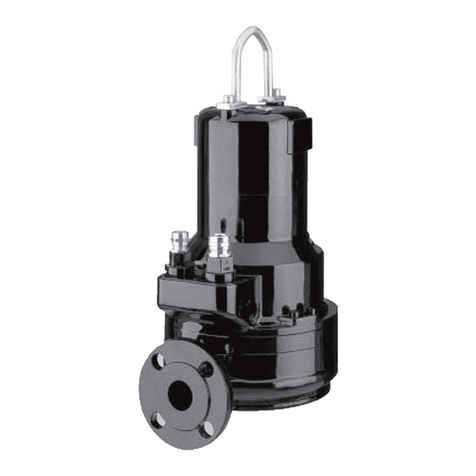
Grundfos
Grundfos APG Installation and operating instructions

Franklin Electric
Franklin Electric Little Giant 555702 HRK-360S instruction sheet

Pumptec
Pumptec 112V Series Operating instructions and parts manual

Virax
Virax 262070 user manual
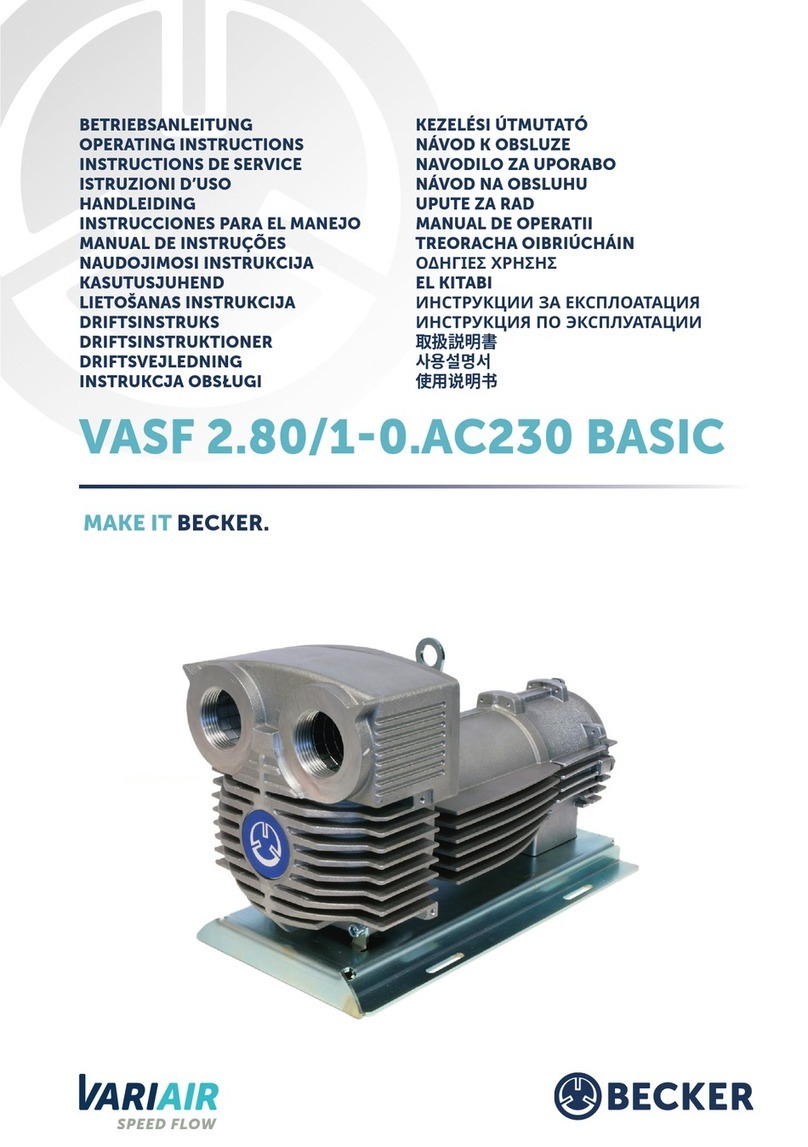
Becker
Becker BASIC VASF 2.80/1-0.AC230 operating instructions


